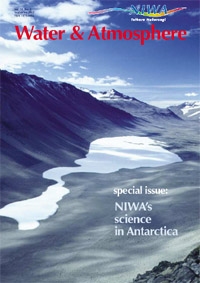PDF of this article (124 KB)

Derek Goring
Why aren’t tides in the far south the same as they are in other places?

The tide in the Ross Sea is completely different from the tide around New Zealand, or indeed in most parts of the world. For a start, there is only one tide per day compared with two in most places. And there is no relationship whatsoever with the Moon’s phase.
This means there are no spring tides at New and Full Moon and no neap tides at First and Last Quarter. Instead, approximately every two weeks, the tide disappears almost completely (see graph).
What causes these differences?
New Zealand and Ross Sea tides
Around New Zealand the main tide is the semidiurnal lunar tide. Semidiurnal means twice daily and lunar means it is caused by the direct gravitational attraction of the Moon on Earth’s waters. Its symbol is M2: M for Moon and subscript 2 for twice daily. M2 is so strong around New Zealand compared to tides caused by other natural phenomena that it governs the timing of high tides that occur every 12 h 24 m.
In the Ross Sea there are two tides which are equally important: K1 and O1. These are called the diurnal declinational tides because they occur once daily and they arise from the track of the Moon as it moves from 29.1 degrees above the equator to 29.1 degrees below the equator over a period of 13.66 days, on average. This is known as the Moon’s declinational path.

The names of the various tides were devised by Sir George Darwin (a son of Charles Darwin) in the 1890s. The Darwin symbols are used universally today. However, the reasons for his choice of many of the symbols (like K and O referred to here) have been lost in time.
A south–north transition
The figure below left shows how the size of the three tides – K1, O1 and M2 – vary as you travel north from the Ross Sea to New Zealand on roughly the same line of longitude. Tide size is measured as amplitude, which is half of the total range of the tide. In the Ross Sea, K1 has an amplitude of about 0.4 m, while O1 has an amplitude of about 0.3 m; but as we move towards New Zealand the amplitude of these two tides decreases, and for most of the New Zealand region they are less than 0.1 m. Contrast this with M2, which is less than 0.1 m in Ross Sea, but increases as we go north to be as high as 0.6 m in northern New Zealand.

Modelling has shown that within the Ross Sea the two main tides, K1 and O1, are quite variable and this is shown in the figures from the cotidal charts. Their amplitude varies from 0.6 m in the central portion and on the south-eastern shoreline to 0.1 m on the north-western headland. High tide occurs on the western side about 3 hours later than on the eastern side.
Tides under the Ross Ice Shelf
Measurements have shown that the Ross Ice Shelf moves up and down with the tide near Scott Base. But this is at the edge of the ice shelf. What about in the south-eastern part of Ross Sea, where the ice is several hundred metres thick? A modelling system known as CATS (developed by Laurie Padman and others at Earth Space Research, Seattle) indicates that the maximum tide (K1 and O1 combined) is very large there (greater than 1 m in amplitude). Does this huge depth of ice float freely on the ocean surface, moving up and down by over 2 m each day? The answer is yes, but we’re not sure how accurate the model is there. Field measurements have been made using gravimeters (they measure the acceleration of ice movement), but the accuracy is low. Another source of evidence is from satellite remote sensing of surface elevations. The coverage is patchy at these latitudes but the data we have confirm both the measurements and the model.
Teachers: this article can be used for NCEA Achievement Standards in Physics (1.2, 1.3, 2.3, 2.7, 3.3, 3.4), Science (1.2, 1.6, 1.7, 3.7, 3.6). See other curriculum connections at www.niwa.co.nz/pubs/wa/resources
Derek Goring is based at NIWA in Christchurch.
Acknowledgements We gratefully acknowledge Antarctica New Zealand, Victoria University of Wellington, and UNAVCO for use of their data. Laurie Padman of Earth Space Research kindly provided output from his CATS model.
Further reading Goring, D.G.; Pyne, A. (2003). Observations of sealevel variability in Ross Sea, Antarctica. NZ Journal of Marine and Freshwater Research 37: 241–249. Padman, L.; Erofeeva, S.; Joughin, I. (2003). Tides of the Ross Sea and Ross Ice Shelf cavity. Antarctic Science 15(1): 31–40.
